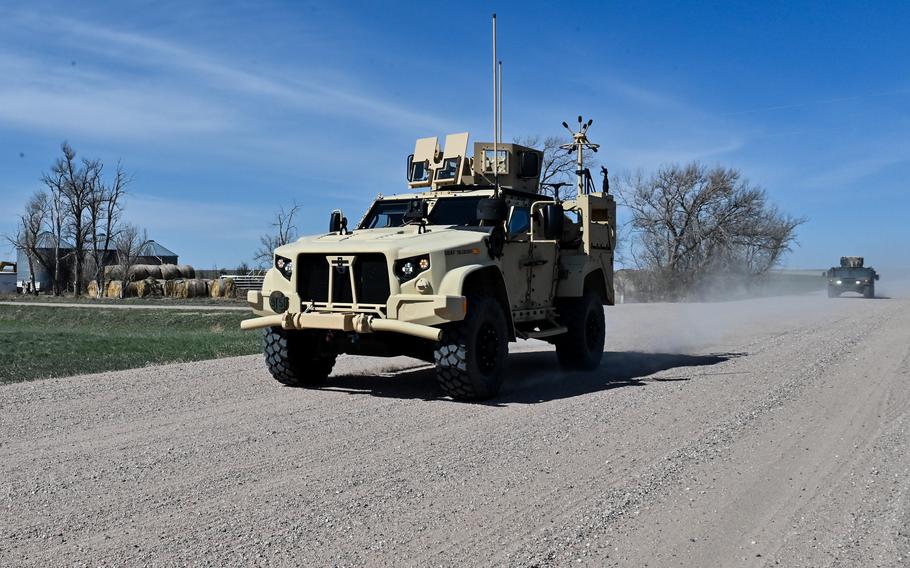
Airmen from the 90th Missile Security Forces Squadron depart F.E. Warren Air Force Base, Wyo., for the first use of the Joint Light Tactical Vehicle supporting maintenance at a launch facility near Harrisburg, Neb., April 24, 2023. (Joseph Coslett Jr./U.S. Air Force)
WASHINGTON — The Air Force for the first time used one of its new Joint Light Tactical Vehicles, an SUV-like vehicle intended to replace the Humvee, service officials said.
Two airmen drove a JLTV for an operational mission in western Nebraska to support launch facility maintenance near the town of Harrisburg, located about 15 miles east of the Nebraska-Wyoming border, the Air Force said. The airmen were from the 90th Missile Security Forces Squadron at F.E. Warren Air Force Base in southeastern Wyoming.
“It is built like a tank,” said Senior Airman Zion Hill, one of the airmen in the vehicle. “When you climb into the Humvee, you are stepping back in time 20 years. The JLTV is like driving the Batmobile into the future to better defend our nation."
“I like being first,” said Staff Sgt. Jeffrey Daniels, the other airman in the vehicle. “It's kind of entertaining, especially driving around on base and off base. You see people taking pictures.”
The U.S. military has been using the Humvee as one of its top utility vehicles since the mid-1980s, but decided years ago that a modern replacement would be needed eventually. In the design stage, the Pentagon wanted a more technically advanced, maneuverable truck that could go anywhere the Humvee could go — but do more than the Humvee could do. Among its features is upgraded armor.
The JLTV’s armor is significant because the first Humvees in the 1980s and 1990s were built without armor plating. It wasn’t until the U.S. sent Humvees to Iraq in the mid-2000s that the Pentagon realized troops needed better protection. To fix the issue, the Defense Department increased the armor on the Humvees that it sent to the Middle East — but there was a trade-off. The armor tended to come at the expense of speed and maneuverability because the added plating made the modified Humvees much heavier.
“The JLTV is a step forward in terms of safety and protection,” U.S. Strategic Command said in a statement. “[It] is a complex vehicle and requires investment in training to ensure operators' safety and skills. Every operator must complete 40 hours of training, both classroom and hands-on familiarization and driving.”
First Lt. Joseph Struzik, 90th Missile Security Operations Squadron officer in charge of logistics and sustainment, said the new vehicles are ultra-modern.
“It is a night and day difference,” Struzik said. “When you climb inside a Humvee you are walking into a historical box … old analog gauges, a classic steering wheel, a center console with a radio. Whereas the JLTV gives defenders a better tool to perform their nuclear-security duties.”
Oshkosh Defense designed and produced the JLTVs for the first several years until Humvee manufacturer AM General beat out the company for an $8.6 billion contract from the Pentagon earlier this year. Under the deal, AM General will deliver 20,000 JLTVs in the next five years. It has several variants and a trailer that adds varying utility and weapons capabilities.
Though the military is now turning to the JLTV, officials have said the Humvee won’t be phased out of service until at least 2050. Once enough of the new vehicles have been delivered, though, the Humvees will serve mainly in a secondary role.
“Many of the defenders who will operate the vehicle, were born after the [Humvee] entered service and are anxious to take advantage of all the new capabilities,” said Air Force Lt. Col. William Brokaw, commander of the 90th Missile Security Forces Squadron.
The Air Force said a number of airmen have already begun training to use the new vehicle.